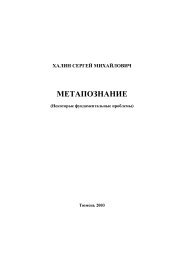The Economic History of Byzantium - Dumbarton Oaks
The Economic History of Byzantium - Dumbarton Oaks
The Economic History of Byzantium - Dumbarton Oaks
You also want an ePaper? Increase the reach of your titles
YUMPU automatically turns print PDFs into web optimized ePapers that Google loves.
988 NICOLAS OIKONOMIDES<br />
and the Balkans. After 730/31, the jurisdiction <strong>of</strong> each royal kommerkion was defined<br />
either by the name <strong>of</strong> a province or by the name <strong>of</strong> a theme, the new military subdivision<br />
<strong>of</strong> the empire which included a number <strong>of</strong> provinces. Indeed, we have an example<br />
<strong>of</strong> a seal belonging to a strategos <strong>of</strong> Mesopotamia that probably dates from 825/6 and<br />
bears a depiction <strong>of</strong> the emperor, presumably because the strategos was exercising powers<br />
similar to those <strong>of</strong> the kommerkiarios at the time. 37 As we shall see below, in the tenth<br />
century the strategos <strong>of</strong> Mesopotamia received the kommerkion <strong>of</strong> his theme rather than<br />
a salary.<br />
Once the state had begun to intervene in trade through civil servants and not by<br />
means <strong>of</strong> entrepreneurs, trade per se naturally passed into the hands <strong>of</strong> private individuals.<br />
<strong>The</strong> civil servants confined themselves primarily to collecting the tax levied by<br />
the state on trade, and they used seals far less magnificent than those <strong>of</strong> the preceding<br />
period. This tax was called the kommerkion after the <strong>of</strong>fice that collected it, and it took<br />
the form <strong>of</strong>either a duty on movements <strong>of</strong> goods or a tax on their sale (though there<br />
was no real difference between the two, given that the kommerkion was refunded on<br />
goods that were reexported, unsold, through Abydos). This process was certainly complete<br />
by the second quarter <strong>of</strong> the ninth century. 38<br />
Administrative Structures<br />
<strong>The</strong> Dark Ages also saw the creation, little by little, <strong>of</strong> the administrative structures <strong>of</strong><br />
the middle Byzantine economic and fiscal services. <strong>The</strong> main administrative change<br />
was the splitting <strong>of</strong> the early Byzantine praefectura praetorio per Orientem and its replacement<br />
by the logothesia (secretariats) in the central administration; the comitiva sacrarum<br />
largitionum and the res privata, too, gave way to their medieval equivalents. Apart from<br />
the changes in nomenclature, these successive administrative reforms led to the subdivision<br />
<strong>of</strong> the services and the creation <strong>of</strong> a whole series <strong>of</strong> public finance <strong>of</strong>fices, which<br />
were directly dependent on the emperor, originated partly in his economic services,<br />
and monitored one another. <strong>The</strong> new administrative arrangement is known to us from<br />
sources <strong>of</strong> the ninth century and will be described below; for the present, I shall try to<br />
present some <strong>of</strong> the stages in its evolution. 39<br />
<strong>The</strong> most widespread transformation seems to have come about as early as the time<br />
<strong>of</strong> Herakleios or his immediate successors. <strong>The</strong>re is testimony from the sixth century<br />
as to the existence <strong>of</strong> the sakellarios, the treasurer in charge <strong>of</strong> the royal money, who<br />
may have been connected with the personal services <strong>of</strong> the emperor. He gained in<br />
importance during the seventh century, controlling payments and thus the mints (<strong>of</strong><br />
Constantinople, Ravenna, and Carthage, in the 7th century). Over time, the <strong>of</strong>fice <strong>of</strong><br />
the sakellarios became still more important; its occupant was detached from the treasury<br />
37 W. Brandes, “Überlegungen zur Vorgeschichte des <strong>The</strong>ma Mesopotamien,” BSl 44.2 (1983):<br />
171–77.<br />
38 Cf. Laiou, “Exchange and Trade,” 705–9, 713–14.<br />
39 Based on Haldon, Seventh Century, 173ff. Cf. also F. Winkelmann, Byzantinische Rang- und Ämterstruktur<br />
im 8. und 9. Jahrhundert (Berlin, 1985).








